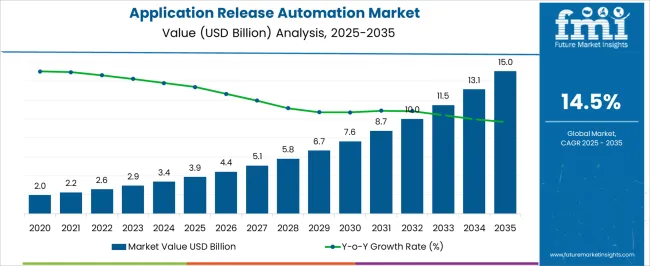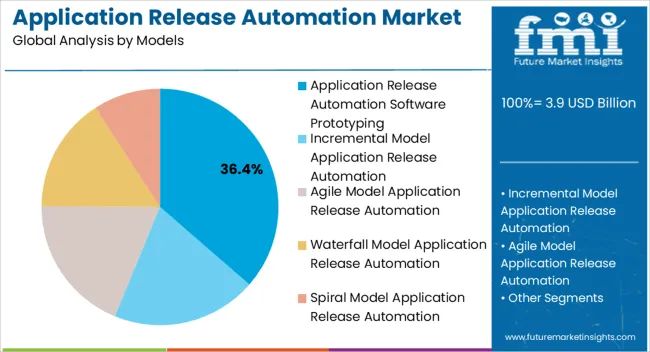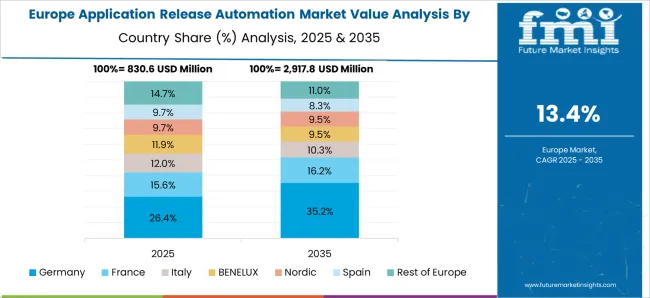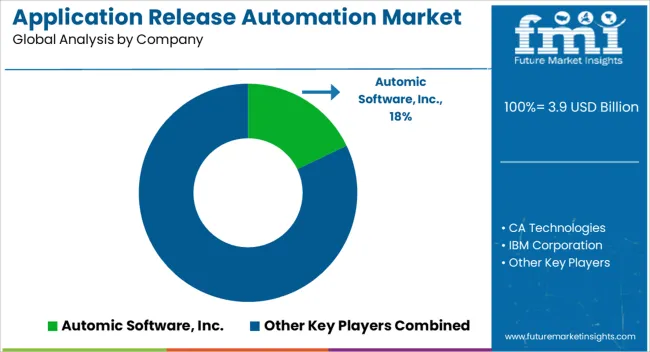The Application Release Automation Market is estimated to be valued at USD 3.9 billion in 2025 and is projected to reach USD 15.0 billion by 2035, registering a compound annual growth rate (CAGR) of 14.5% over the forecast period.

| Metric | Value |
|---|---|
| Application Release Automation Market Estimated Value in (2025 E) | USD 3.9 billion |
| Application Release Automation Market Forecast Value in (2035 F) | USD 15.0 billion |
| Forecast CAGR (2025 to 2035) | 14.5% |
The Application Release Automation market is experiencing steady growth, driven by the increasing adoption of DevOps practices, continuous integration, and continuous deployment frameworks across software development organizations. Organizations are prioritizing faster, more reliable application releases to enhance operational efficiency, reduce downtime, and improve end-user satisfaction. The market is further supported by advancements in automation technologies that enable streamlined deployment, testing, and version control processes.
Cloud adoption, agile development methodologies, and the need for multi-environment release orchestration are enhancing the demand for scalable release automation platforms. Application Release Automation solutions also facilitate compliance with security and regulatory requirements by enabling standardized, auditable processes. Continuous improvements in AI-driven analytics and predictive monitoring are strengthening operational reliability and minimizing deployment risks.
As organizations increasingly focus on accelerating software delivery while maintaining quality, the Application Release Automation market is poised for sustained expansion Investment in automation, integration capabilities, and support for hybrid and multi-cloud environments is expected to further drive growth over the coming years.

The application release automation software prototyping segment is projected to hold 36.4% of the market revenue in 2025, positioning it as the leading model type. Its growth is being driven by the increasing demand for platforms that facilitate the design, testing, and deployment of software in a controlled, iterative environment. This segment enables rapid prototyping of applications, allowing development teams to validate functionality, performance, and user experience before full-scale deployment.
Integration with DevOps tools, continuous integration pipelines, and automated testing frameworks enhances operational efficiency and reduces release-related risks. The ability to simulate production environments and evaluate release strategies without impacting live systems is a key advantage. Organizations are leveraging these models to accelerate time-to-market, ensure consistency across multiple releases, and maintain compliance with industry standards.
Scalability, customization, and support for hybrid deployment environments further strengthen the adoption of software prototyping models As enterprises continue to pursue agile and automated software delivery, this segment is expected to retain its leadership position, driven by technological innovation and operational effectiveness.
Growing Dependence on IT Services to Strengthen the Market
Dependency on IT services has magnified the demand for data centers across the globe. In February 2024, Microsoft announced to open a data center region in Spain to assist in the acceleration of the digital transformation of public and private entities of all sizes. It may help them to scale, innovate, and migrate their businesses to the cloud in a secure way and it may also drive the market in the forecasted period.
Furthermore, agility and speed to market are increasing growth factors for the application release automation market. Version control or source control helps facilitate the entire software team in envisioning product code changes. Application release automation ensures full uptime by scheduling upgrades in real time and on the go.
All leading public cloud hosts (AWS, Microsoft Azure, Google, IBM, Oracle, HP, etc.) have proprietary application release automation platforms available for enterprise software development and lifecycle management.
The application release automation market has its share of limitations, including failed execution of software or applications and the enormity of configurations that put a barrier to the growth of the application release automation market. Other factors hampering the market growth include poor traceability between incident records and release records and poor traceability between incident records release records.
However, increasing expenditure on digital transformation is expected to counter the hampering factors and act as a significant opportunity for the market.
For instance, in February 2024, Microsoft announced the continuation of its plan, 'Innovate for Mexico,' to contribute to the country's development. The most vital pillar of the initiative is focused on boosting Mexico's digital transformation through democratizing access to technology.
The company announced plans to establish a new cloud data center region in Mexico to deliver its intelligent and trusted cloud services to serve Mexico’s public entities, organizations, and Mexican society, including Microsoft Azure, Office 365, Dynamics 365, and the Power Platform.
IT and Telecommunications to Offer Immense Growth Opportunities to the Application Release Automation Market
According to Ericson's 2020 report on the mobile industry, by 2025, 3.9 billion 5G cellular subscriptions may boost the demand for IoT devices. The reduced prices of smartphones and laptops and the development of IoT owing to technological evolution have transformed the globe into a cluster of billions of connected devices that have generated the need to be updated quickly to be secure, productive, and efficient.
An increase in the rapid expansion of 5G availability is boosting the growth of IoT in several sectors and thus strengthening the market. IT and Telecommunications sector is projected to have remunerative growth opportunities for the application release automation market during the forecast period.
| Countries | Revenue Share % (2025) |
|---|---|
| United States | 13.2% |
| Germany | 10.1% |
| Japan | 4.3% |
| Australia | 2.4% |
| North America | 30.2% |
| Europe | 18.2% |
| Countries | CAGR % (2025 to 2035) |
|---|---|
| China | 13.2% |
| India | 18.2% |
| United Kingdom | 9.2% |
Presence of Giant Players in the Region to Benefit the Regional Market
North America is slated to hold the leading share of the application release automation market during the forecast period. The market share of North America in 2025 is listed at 30.2%.
According to World Economic Forum 2020 Global Competitive Index, the United States dominates the global market in technological innovation. The country leads the market owing to its business dynamism, financing mechanisms, and vibrant innovation ecosystem.
Companies in the region are making significant investments to add new specifications and better user interfaces, thus, controlling the market. In 2020, Airbnb, Inc. made a significant foundational investment to augment and support its community for the forthcoming years.
It included investing in building out and marketing new initiatives and offerings such as Airbnb Experiences, Airbnb Luxe, Airbnb Plus, Airbnb China, and hotel improvements to the technology platform. Attributed to such factors, North America is expected to maintain its dominant position in the market throughout the forecast period.
Increasing Expenditure on Digital Transformation to Augment the Regional Market Size

Europe is projected to be the second-leading market for the application release automation market. In 2025, the region is likely to procure about 18.2% of the global revenue. This can be attributed to the growing investment in digital transformation.
The presence of renowned companies in the region is projected to offer various growth opportunities to the regional market during the forecast period. Players such as Accenture, SAP, Capgemini, Micro Focus, and others are likely to make a significant contribution in augmenting the market size in the forecast period.
In September 2024, Accenture announced the formation of Accenture Cloud First with an investment of USD 3 billion over three years to help clients across all industries rapidly become ‘cloud first’ enterprises and boost their digital transformation to realize greater value at speed and scale.
Favorable Initiatives Taken by Players of Developing Countries to Boost the Regional Market.
The market for application release automation is expected to witness significant opportunities for expansion in the APAC region. This can be attributed to the presence of developing nations like India, China, Japan, and others, making significant investments to expedite digital transformation and favorable initiatives by regional players.
In 2025, Malaysia’s Alibaba Cloud Intelligence’s general manager Kun Huang announced a new program called Alibaba Cloud Digital Empowerment Program.
The initiative aims to grow resources into programs, including cloud credit empowerment, training workshops, and dedicated tech service to boost the company's cloud journey and augment the digitalization potential amid the post-pandemic era. Such initiatives in the region are expected to benefit the regional market during the forecast period.
Chef (United States), Authorize (Israel), RobCorp (United States), Leapwork (Denmark), Red Points (Spain), PatSnap (Singapore), Questel (France), SnapDragon Monitoring (United Kingdom), and Flowhaven (2020), are some emerging names in the global application release automation market.
New players in the market are taking various initiatives to strengthen their position in the market. Flowhaven, a Finnish company established in 2020, offers real-time cloud-based license management solutions. It enables users to manage team workflows, helps to reduce time spent on reviews, and enhances intellectual property monetization solutions. It also provides customer management tools and evaluates the profitability of deals.
In January 2024, the company closed at USD 16 million in Series A funding. The new round was led by Sapphire Sport, the part of Sapphire Ventures that specializes in sports, media, and lifestyle brands-existing investors Global Founders Capital and Icebreaker. Vc also returned, bringing Flowhaven’s total raise to date to USD 21.5 million.

Key players in the global application release automation market include Clarive Software S.L, CA Technologies, Automic Software, IBM Corporation VMware, Inc., HP, Inc., Electric Cloud, Inc., BMC Software, Serena Software, Inc., and XebiaLabs, Inc.
Recent Developments:
The global application release automation market is estimated to be valued at USD 3.9 billion in 2025.
The market size for the application release automation market is projected to reach USD 15.0 billion by 2035.
The application release automation market is expected to grow at a 14.5% CAGR between 2025 and 2035.
The key product types in application release automation market are application release automation software prototyping, incremental model application release automation, agile model application release automation, waterfall model application release automation and spiral model application release automation.
In terms of , segment to command 0.0% share in the application release automation market in 2025.






Our Research Products

The "Full Research Suite" delivers actionable market intel, deep dives on markets or technologies, so clients act faster, cut risk, and unlock growth.

The Leaderboard benchmarks and ranks top vendors, classifying them as Established Leaders, Leading Challengers, or Disruptors & Challengers.

Locates where complements amplify value and substitutes erode it, forecasting net impact by horizon

We deliver granular, decision-grade intel: market sizing, 5-year forecasts, pricing, adoption, usage, revenue, and operational KPIs—plus competitor tracking, regulation, and value chains—across 60 countries broadly.

Spot the shifts before they hit your P&L. We track inflection points, adoption curves, pricing moves, and ecosystem plays to show where demand is heading, why it is changing, and what to do next across high-growth markets and disruptive tech

Real-time reads of user behavior. We track shifting priorities, perceptions of today’s and next-gen services, and provider experience, then pace how fast tech moves from trial to adoption, blending buyer, consumer, and channel inputs with social signals (#WhySwitch, #UX).

Partner with our analyst team to build a custom report designed around your business priorities. From analysing market trends to assessing competitors or crafting bespoke datasets, we tailor insights to your needs.
Supplier Intelligence
Discovery & Profiling
Capacity & Footprint
Performance & Risk
Compliance & Governance
Commercial Readiness
Who Supplies Whom
Scorecards & Shortlists
Playbooks & Docs
Category Intelligence
Definition & Scope
Demand & Use Cases
Cost Drivers
Market Structure
Supply Chain Map
Trade & Policy
Operating Norms
Deliverables
Buyer Intelligence
Account Basics
Spend & Scope
Procurement Model
Vendor Requirements
Terms & Policies
Entry Strategy
Pain Points & Triggers
Outputs
Pricing Analysis
Benchmarks
Trends
Should-Cost
Indexation
Landed Cost
Commercial Terms
Deliverables
Brand Analysis
Positioning & Value Prop
Share & Presence
Customer Evidence
Go-to-Market
Digital & Reputation
Compliance & Trust
KPIs & Gaps
Outputs
Full Research Suite comprises of:
Market outlook & trends analysis
Interviews & case studies
Strategic recommendations
Vendor profiles & capabilities analysis
5-year forecasts
8 regions and 60+ country-level data splits
Market segment data splits
12 months of continuous data updates
DELIVERED AS:
PDF EXCEL ONLINE
Application Crowdtesting Service Market Size and Share Forecast Outlook 2025 to 2035
Application Integration Market Size and Share Forecast Outlook 2025 to 2035
Application Programming Interface (API) Security Market Size and Share Forecast Outlook 2025 to 2035
Application Development and Modernization (ADM) Market Size and Share Forecast Outlook 2025 to 2035
Application Delivery Controllers Market Size and Share Forecast Outlook 2025 to 2035
Application Virtualization Market Size and Share Forecast Outlook 2025 to 2035
Release Tapes Market Size and Share Forecast Outlook 2025 to 2035
Automation Testing Market Size and Share Forecast Outlook 2025 to 2035
Application Specific Integrated Circuit Market Size and Share Forecast Outlook 2025 to 2035
Application Processor Market Size and Share Forecast Outlook 2025 to 2035
Release Agent Market – Trends & Forecast 2025 to 2035
Application Delivery Network Market by Product, End-user, Environment, Deployment Type, Vertical, and Region, Forecast through 2035
Automation COE Market Insights by Organization Size, Service Type, End User Verticals, and Region through 2035
Application Control Software Market Insights – Growth & Forecast 2025-2035
Application Metrics and Monitoring Tools Market Analysis By Component, Mode, Deployment, Verticals, and Region through 2035
Release Liner Recycling Market
Application Centric Infrastructure Market
Application Management Services Market Analysis – Trends & Forecast 2017-2027
IoT Application Enablement Market Size and Share Forecast Outlook 2025 to 2035
IoT Application Development Services Market Size and Share Forecast Outlook 2025 to 2035

Thank you!
You will receive an email from our Business Development Manager. Please be sure to check your SPAM/JUNK folder too.
Chat With
MaRIA